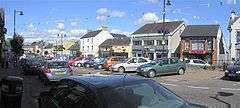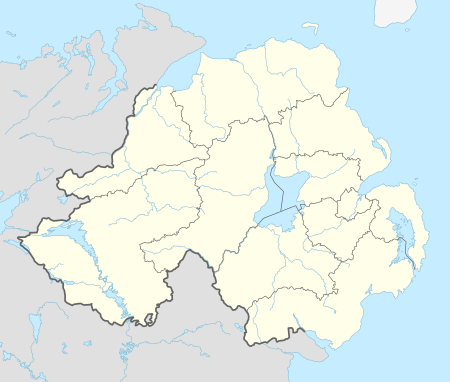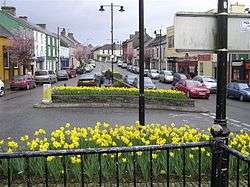Irvinestown
| Irvinestown | |
| Scots: Irvinestoun[1] | |
| Irish: Baile an Irbhinigh[2] | |
 |
|
 Irvinestown |
|
| Population | 2,081 (2008 estimate) |
|---|---|
| Irish grid reference | H235582 |
| District | Fermanagh and Omagh |
| County | County Fermanagh |
| Country | Northern Ireland |
| Sovereign state | United Kingdom |
| Post town | Enniskillen |
| Postcode district | BT94 |
| Dialling code | 028, +44 28 |
| EU Parliament | Northern Ireland |
| UK Parliament | Fermanagh and South Tyrone |
| NI Assembly | Fermanagh and South Tyrone |
|
|
Coordinates: 54°28′16″N 7°38′02″W / 54.471°N 7.634°W
Irvinestown is a town in County Fermanagh, Northern Ireland. In 2008 it had an estimated population of 2,081 people. The most notable building is the ruined 18th-century church. It is situated within Fermanagh and Omagh district.
History
Before the Plantation of Ulster, the area was known as Necarne or Nakerny. The village was founded during the Plantation in 1618 by Sir Gerald Lowther and named Lowtherstown. Ownership later passed to the Irvines of Dumfries and the name changed accordingly.
Places of interest
- Nearby is Necarne Castle, formerly known as Castle Irvine, which is now an equestrian school – Necarne Castle Equestrian School.
- The village also boasts the annual Lady of The Lake Festival, a large 10-day summer festival and carnival which begins on the first Friday following the 12th of July. It is the largest cross-community Festival to be held in Northern Ireland and is named after the mythical figure which is said to appear gliding over the waters of Lower Lough Erne, wearing a flowing blue gown and carrying a bunch of flowers. The Lady is said to be an omen of good times to come.
- The nearby Castle Archdale Country Park on the shores of Lower Lough Erne was used as an RAF base for Sunderland flying boats in WWII, with Catalina flying boats at RAF Killadeas, and today provides lakeshore & woodland walking/cycling paths, gardens, caravan park, campsite, tea rooms and boating marina. Other features within the park include a red deer enclosure, wildfowl ponds, nature trail, butterfly garden and wildflower meadow.
Transport
Irvinestown railway station on the Enniskillen and Bundoran Railway was opened on 13 June 1866 and closed on 1 October 1957.[3] Ulsterbus routes 194 (Enniskillen to Pettigo), 83 (Irvinestown to Omagh) and 94A (Enniskillen to Omagh) stop in Irvinestown.
People
- Mrs Delaney, wife of Patrick Delaney, Rector of Irvinestown in the 18th century and later Bishop of Down, was a key figure on the London literary scene prior to her marriage, mixing with Alexander Pope, Edmund Burke, Hugh Walpole and Jonathan Swift. Her biography provides a notable record of both the literary scene and life of the Anglo-Irish gentry at the time.
- Sinéad Quinn, a singer/songwriter who came second in the first series of BBC's Fame Academy, and has since recorded an album entitled "Ready To Run".

Sport
The village also has a number of sporting organisations such as Irvinestown Wanderers Football Club, St. Molaise's GAA, Irvinestown Tennis Club and more. The Bawnacre leisure centre provides many sporting facilities including squash courts, tennis courts, indoor & outdoor football, indoor gymnasium and sauna / steam room. It is a rich haven of sport and recreation in the area a fact recognised when the long-serving manager George Beacom was given an OBE for services to sport in the local community.
GAA
St. Molaise GAA Gaelic football team can trace its roots to 1918 when the team was represented at the county convention of that year by C. Browne, P. Rafferty and J. Maguire. Previously hurling was played with teams fielded by Tummery and Glassmullagh.
As the national spirit of the time penetrated local areas, Irvinestown gaels wanted to express their nationality by playing Gaelic Football. The first recorded match was played at a sports day on 15 August against Fintona Pearses at Loughterash, Kilskeery and Fintona won by a 0-5 to 0-3 scoreline. The game was played in Kilskeery because of a ban on G.A.A. activities at the time meant that St. Molaise's home pitch, a field belonging to John Maguire at Drumharvey, was under the watchful eye of three hundred soldiers and R.I.C. who had cycled into the village from early morning suitably equipped for any ensuing trouble.
The troubles of the 1920s disrupted the playing of league games and it was not until 1924 that Tommy Maguire, Jimmy Thompson and Father Lappin made efforts to get the game going again. A hall committee was set up to organise building a hall as a focal point for meetings, fund raising, etc. and St.Molaise Hall was officially opened on 13 September 1925.
In 1924 the old football field at Drumharvey was no longer available so the club moved to a field on the Dromore Road for which they paid £10 a year rent. The cost of admission was 6d but nobody wanted to pay and spectators were content to stand on the road to view the game. Not to be out done the club made a large screen of meal bags sewn together forcing the spectators to come inside. St Molaise Park was officially opened on 11 May 1947. Eighteen months previously a group of men had travelled to see a game in Clones and were impressed with their new field and decided that Irvinestown should have one similar. They selected a site in Bridge Street costing £500 and after tender awarded the contract of preparing the field and surround to J.J. Scallon and Sons. Special trains and buses from all over the North ran into Irvinestown,for the opening which was performed by Mr Daniel O'Rourke T.D., President of the G.A.A. Tummery and Coa pipe bands were there to entertain the 10,000 crowd. The opening match was Lisnaskea vs. West Ulster selection, refereed by Johnny Monaghan, Ederney, followed by Roscommon (All-Ireland finalists 1946) and Antrim (All-Ireland semi finalists 1946) refereed by Jim Vallely, Armagh.
Annual Truck Festival
The Irvinestown Truck Festival was launched in 2000 and is celebrating 10 years in 2010. This is a 60-mile (100 km) drive around the Fermanagh lakes where the spectacle of trucks raises funds for Marie Curie Cancer Care. The 2010 event took place on the weekend of 23–25 July; the convoy taking place on the 25th. As many as 700 lorries have taken part in this event in the past (unofficially breaking the world record by quite a margin) and what a spectacle it is.
2001 Census
Irvinestown is classified as a village by the NI Statistics and Research Agency (NISRA) (i.e. with population between 1,000 and 2,250 people). On Census day (29 April 2001) there were 1,801 people living in Irvinestown. Of these:
- 23.0% were aged under 16 years and 20.7% were aged 60 and over
- 45.5% of the population were male and 54.5% were female
- 75.0% were from a Catholic background and 23.9% were from a Protestant background
- 7.1% of people aged 16–74 were unemployed.
See also
References
- ↑ Tully Castle (Ulster-Scots translation) Department of the Environment.
- ↑ Placenames Database of Ireland
- ↑ "Irvinestown station" (PDF). Railscot - Irish Railways. Retrieved 2007-10-16.
- Enniskillen.com
- Culture Northern Ireland
- NI Neighbourhood Information Service
- http://www.ninis.nisra.gov.uk/mapxtreme_towns/PopChangesFacts/Irvinestown.pdf